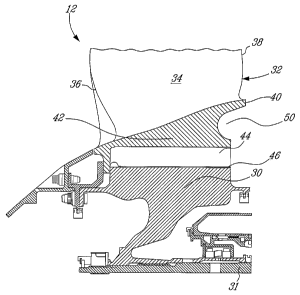Une partie des informations de ce site Web a été fournie par des sources externes. Le gouvernement du Canada n'assume aucune responsabilité concernant la précision, l'actualité ou la fiabilité des informations fournies par les sources externes. Les utilisateurs qui désirent employer cette information devraient consulter directement la source des informations. Le contenu fourni par les sources externes n'est pas assujetti aux exigences sur les langues officielles, la protection des renseignements personnels et l'accessibilité.
L'apparition de différences dans le texte et l'image des Revendications et de l'Abrégé dépend du moment auquel le document est publié. Les textes des Revendications et de l'Abrégé sont affichés :
| (12) Brevet: | (11) CA 2566527 |
|---|---|
| (54) Titre français: | REGLAGE DE LA FREQUENCE NATURELLE DES AUBES DE MOTEURS A TURBINE A GAZ |
| (54) Titre anglais: | NATURAL FREQUENCY TUNING OF GAS TURBINE ENGINE BLADES |
| Statut: | Octroyé |
| (51) Classification internationale des brevets (CIB): |
|
|---|---|
| (72) Inventeurs : |
|
| (73) Titulaires : |
|
| (71) Demandeurs : |
|
| (74) Agent: | NORTON ROSE FULBRIGHT CANADA LLP/S.E.N.C.R.L., S.R.L. |
| (74) Co-agent: | |
| (45) Délivré: | 2012-04-17 |
| (86) Date de dépôt PCT: | 2005-05-11 |
| (87) Mise à la disponibilité du public: | 2005-11-24 |
| Requête d'examen: | 2009-06-09 |
| Licence disponible: | S.O. |
| (25) Langue des documents déposés: | Anglais |
| Traité de coopération en matière de brevets (PCT): | Oui |
|---|---|
| (86) Numéro de la demande PCT: | PCT/CA2005/000721 |
| (87) Numéro de publication internationale PCT: | WO2005/111377 |
| (85) Entrée nationale: | 2006-11-14 |
| (30) Données de priorité de la demande: | ||||||
|---|---|---|---|---|---|---|
|
Une aube de turbine à gaz (32) telle qu'une aube de soufflante à aubes variables comporte une encoche de réglage (50) usinée dans la partie arrière, à la racine (42) de l'aube, entre une plate-forme (40) et une queue d'aronde (44). Le choix approprié des dimensions et de l'emplacement de l'encoche permettent de modifier la fréquence naturelle de l'aube. De cette manière, l'encoche peut être conçue pour modifier la fréquence naturelle de l'aube de façon à éviter toute coïncidence avec des fréquences d'excitation aérodynamique sans affecter pour autant l'aérodynamique de l'aube. L'invention concerne aussi un procédé correspondant de réglage de la fréquence naturelle de l'aube d'une turbine à gaz.
A gas turbine engine blade (32), such as a swept fan blade, having a tuning
notch (50) machined in the back of a blade root (42) between a platform (40)
and dovetail (44). Proper sizing and location of the notch allow for the
natural frequency of the blade to be modified. In this way, the notch can be
designed to alter the natural frequency of the blade so as to avoid
coincidence with the known aerodynamic excitation frequencies while not
effecting blade aerodynamics. An associated method of tuning the natural
frequency of a gas turbine blade is also disclosed.
Note : Les revendications sont présentées dans la langue officielle dans laquelle elles ont été soumises.
Note : Les descriptions sont présentées dans la langue officielle dans laquelle elles ont été soumises.

Pour une meilleure compréhension de l'état de la demande ou brevet qui figure sur cette page, la rubrique Mise en garde , et les descriptions de Brevet , États administratifs , Taxes périodiques et Historique des paiements devraient être consultées.
| Titre | Date |
|---|---|
| Date de délivrance prévu | 2012-04-17 |
| (86) Date de dépôt PCT | 2005-05-11 |
| (87) Date de publication PCT | 2005-11-24 |
| (85) Entrée nationale | 2006-11-14 |
| Requête d'examen | 2009-06-09 |
| (45) Délivré | 2012-04-17 |
Il n'y a pas d'historique d'abandonnement
Les titulaires actuels et antérieures au dossier sont affichés en ordre alphabétique.
| Titulaires actuels au dossier |
|---|
| PRATT & WHITNEY CANADA CORP. |
| Titulaires antérieures au dossier |
|---|
| STONE, PAUL |